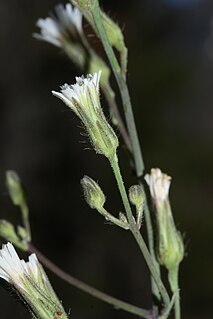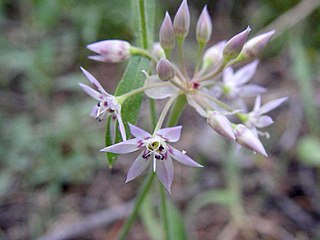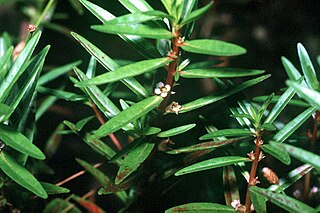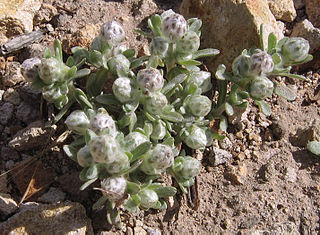
Jasmine is a genus of shrubs and vines in the olive family (Oleaceae). It contains around 200 species native to tropical and warm temperate regions of Eurasia, Africa, and Oceania. Jasmines are widely cultivated for the characteristic fragrance of their flowers. A number of unrelated plants contain the word "jasmine" in their common names.

Langloisia setosissima, the bristly langloisia, bristly-calico, Great Basin langloisia or lilac sunbonnets, is a flowering plant, the sole species in the genus Langloisia in the family Polemoniaceae. It is native to the western United States and north western Mexico, where it is found in desert washes and on rocky slopes and plains from eastern Oregon and Idaho, south via Nevada and Utah to eastern California and Arizona.

Hieracium albiflorum, known by the names white hawkweed and white-flowered hawkweed, is a common and widespread species of plant in the family Asteraceae.

Mertensia virginica is a spring ephemeral plant with bell-shaped sky-blue flowers, native to eastern North America.

Aronia arbutifolia, called the red chokeberry, is a North American species of shrubs in the rose family. It is native to eastern Canada and to the eastern and central United States, from eastern Texas to Nova Scotia inland to Ontario, Ohio, Kentucky, and Oklahoma.

Stellaria graminea is a species of flowering plant in the family Caryophyllaceae known by the common names common starwort, grass-leaved stitchwort, lesser stitchwort and grass-like starwort.

Rosa gymnocarpa is a species of rose native to western North America. It is known by the common names dwarf rose, baldhip rose, and wood rose. It grows in shady, damp, and rich forests.

Allium campanulatum is a species of wild onion known by the common name dusky onion or Sierra onion. This is a flowering plant native to the western United States from southeastern Washington and northern Oregon to southern California, and western Nevada. The dusky onion grows in foothills and mountains, especially in dry areas, such as chaparral habitats.
Galium matthewsii is a species of flowering plant in the coffee family known by the common names bushy bedstraw and Matthews' bedstraw. It is native to the mountains and deserts of southeastern California, and southern Nevada.

Allium cratericola is a species of wild onion known by the common name Cascade onion. It is endemic to California, where is an uncommon member of the flora in several of the state's mountain ranges, including the northern and southern California Coast Ranges, the western Transverse Ranges, Klamath Mountains, and the Sierra Nevada foothills. Its range covers much of the state, from Riverside County to Siskiyou County.

Loeseliastrum (calico) is a small genus of flowering plants in the phlox family.
Loeseliastrum depressum is a species of flowering plant in the phlox family known by the common name depressed ipomopsis. It is native to the deserts of the southwestern United States, where it grows in sandy habitat. It is a petite, decumbent annual herb forming a small clump on the ground, its hairy, glandular stems no more than 10 centimeters long. The leaves are linear to oval and pointed, each not more than 2 centimeters long. They are coated in white hairs. The inflorescence is a dense cluster of tiny white flowers, each pointed corolla lobe just a millimeter long or so.

Reseda alba is a species of flowering plant in the reseda family known by the common names white mignonette or white upright mignonette. It is native to Europe, Asia, and North Africa, and it can be found in parts of the Americas and Australia as an introduced species. It is also cultivated as an ornamental plant for its spikelike racemes of fragrant white flowers. This is an annual or perennial herb growing up to a meter tall. The leaves are divided deeply into many narrow lobes. The inflorescence, which may take up most of the upper stem, is densely packed with many white flowers. Each flower has five or six petals, each of which is divided into three long, narrow lobes, making the raceme appear frilly. The fruit is a nearly rectangular four-angled capsule up to 1.4 centimeters in length.

Rotala ramosior is a species of flowering plant in the loosestrife family known by the common name lowland rotala. This aquatic or semiaquatic plant is native to North America, where it grows in lakes, streams, and irrigation ditches. The branching stems of the plant grow to about 40 cm long. Leaves are decussate, arranged oppositely in perpendicular pairs along the stems. The leaves are linear to lance-shaped to oval and up to 5 cm long. Flowers occur singly in leaf axils. Each has triangular sepals with long, narrow appendages and usually four tiny white petals in shades of pink to white. This plant is sometimes grown in aquariums.

Silene douglasii is a species of flowering plant in the family Caryophyllaceae known by the common name Douglas's catchfly.

Stylocline gnaphaloides is a species of flowering plant in the aster family known by the common names mountain neststraw and everlasting neststraw.

Torilis arvensis is a species of flowering plant in the family Apiaceae known by the common names spreading hedgeparsley, tall sock-destroyer and common hedge parsley. It is native to parts of Europe and it is known elsewhere, such as North America, as an introduced species and a common weed. It grows in many types of habitat, especially disturbed areas. It is an annual herb producing a slender, branching, rough-haired stem up to a meter in maximum height. The alternately arranged leaves are each divided into several pairs of lance-shaped leaflets up to 6 centimeters long each. The leaflet is divided or deeply cut into segments or teeth. The inflorescence is a wide open compound umbel of flower clusters on long, slender rays. Each flower has five petals which are unequal in size and are white with a pinkish or reddish tinge. Each greenish or pinkish fruit is 3 to 5 millimeters long and is coated in straight or curving prickles.

Torilis nodosa is a species of flowering plant in the family Apiaceae known by the common names knotted hedgeparsley and short sock-destroyer. It is native to parts of Europe, especially the Mediterranean Basin and it is known elsewhere, such as North America, as an introduced species and a common weed. It grows in many types of habitat, particularly disturbed areas. It is an annual herb producing a hairy stem up to half a meter in maximum height. The alternately arranged leaves are each divided into several pairs of smooth-edged lance-shaped or linear leaflets. The inflorescence is a dense compound umbel of flower clusters on very short rays, often appearing like a cluster. Each flower has five petals which are unequal in size and are white with a pinkish or reddish tinge. Each greenish or pinkish fruit is about 3 millimeters long and is coated in long prickles.
Erigeron consimilis is a North American species of flowering plants in the family Asteraceae known by the common names foothill fleabane and San Rafael fleabane. It is found in the western United States: Arizona, New Mexico, Utah, Colorado, Wyoming.

Myosotis matthewsii is a species of flowering plant in the family Boraginaceae, endemic to the North Island of New Zealand. Lucy Moore described the species in 1961. Plants of this species of forget-me-not are perennial rosettes with bracteate inflorescences and white corollas.

















